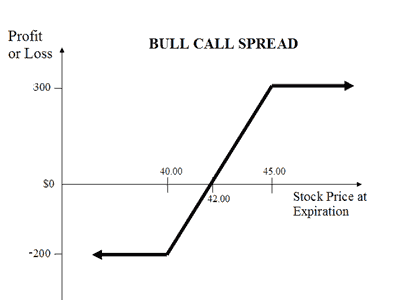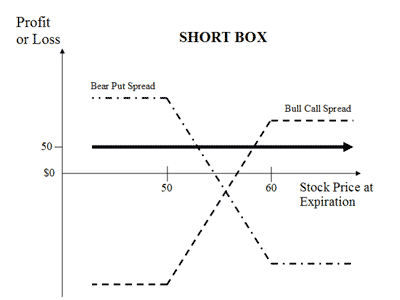 Zerodha (Trading Account)
Zerodha (Trading Account)
FREE Equity Delivery and MF
Flat ₹20/trade Intra-day/F&O
 Zerodha (Trading Account)
Zerodha (Trading Account)
FREE Equity Delivery and MF
Flat ₹20/trade Intra-day/F&O

|
|
Compare Bull Call Spread and Short Box (Arbitrage) options trading strategies. Find similarities and differences between Bull Call Spread and Short Box (Arbitrage) strategies. Find the best options trading strategy for your trading needs.
| Bull Call Spread | Short Box (Arbitrage) | |
|---|---|---|
 |
 |
|
| About Strategy | A Bull Call Spread (or Bull Call Debit Spread) strategy is meant for investors who are moderately bullish of the market and are expecting mild rise in the price of underlying. The strategy involves taking two positions of buying a Call Option and selling of a Call Option. The risk and reward in this strategy is limited. A Bull Call Spread strategy involves Buy ITM Call Option and Sell OTM Call Option.For example, if you are of the view that NIFTY will rise moderately in near future then you can Buy NIFTY Call Option at ITM and Sell Nifty Call Option at OTM. You will earn massively when both of your Options are exercised and incur huge losses when both Options are not exercised. | Short Box is an arbitrage strategy. It involves selling a Bull Call Spread (1 ITM and I OTM Call) together with the corresponding Bear Put Spread (1 ITM and 1 OTM Put), with both spreads having the same strike prices and expiration dates. The short box strategy is opposite to Long Box (or Box Spread). It is used when the spreads are overpriced with respect to their combined expiration value. This strategy is the combination of 2 spreads (4 trades) and the profit/loss calculated together as 1 trade. Note that the 'total cost of the box remain same' irrespective to the price movement of underlying security in any direction. The expiration value of the box spread is actually the difference between the strike prices of the options involved. ... Read More |
| Market View | Bullish | Neutral |
| Strategy Level | Beginners | Advance |
| Options Type | Call | Call + Put |
| Number of Positions | 2 | 4 |
| Risk Profile | Limited | None |
| Reward Profile | Limited | Limited |
| Breakeven Point | Strike price of purchased call + net premium paid | |
| Bull Call Spread | Short Box (Arbitrage) | |
|---|---|---|
| When to use? | A Bull Call Spread strategy works well when you're Bullish of the market but expect the underlying to gain mildly in near future. |
Being risks free arbitrage strategy, this strategy can earn better return than earnings in interest from fixed deposits for any investor. The earning from this strategy varies with the strike price chosen by the trader. i.e. Earning from strike price '10400, 10700' will be different from strike price combination of '9800,11000'. The short box strategy should be used when the component spreads are overpriced in relation to their expiration values. In most cases, the trader has to hold the position till expiry to gain the benefits of the price difference. Note: If the spreads are underpriced, another strategy named Long Box (or Box Spread) can be used for a profit. This strategy should be used by advanced traders as the gains are minimal. The brokerage payable when implementing this strategy can take away all the profits. This strategy should only be implemented when the fees paid are lower than the expected profit. |
| Market View | Bullish When you are expecting a moderate rise in the price of the underlying. |
Neutral The market view for this strategy is neutral. The movement in underlying security doesn't affect the outcome (profit/loss). This arbitrage strategy is to earn small profits irrespective of the market movements in any direction. |
| Action |
A Bull Call Spread strategy involves Buy ITM Call Option + Sell OTM Call Option. For example, if you are of the view that Nifty will rise moderately in near future then you can Buy NIFTY Call Option at ITM and Sell NIFTY 50 Call Option at OTM. You will earn massively when both of your Options are exercised and incur huge losses when both Options are not exercised. |
Say for XYZ stock, the component spread is relatively overpriced than its underlying. You can execute execute Short Box strategy by selling 1 ITM Call and 1 ITM Put while buying 1 OTM Call and 1 OTM Put. There is no risk of loss while the profit potential would be the difference between two strike prices minus net premium. |
| Breakeven Point | Strike price of purchased call + net premium paid |
| Bull Call Spread | Short Box (Arbitrage) | |
|---|---|---|
| Risks | Limited The trade will result in a loss if the price of the underlying decreases at expiration. The maximum loss is limited to net premium paid. Max Loss = Net Premium Paid Max Loss happens when the strike price of Call is less than or equal to price of the underlying. |
None The Short Box Spread Options Strategy is a relatively risk-free strategy. There is no risk in the overall position because the losses in one spread will be neutralized by the gains in the other spread. The trades are also risk-free as they are executed on an exchange and therefore cleared and guaranteed by the exchange. The small risks of this strategy include:
|
| Rewards | Limited Limited To The Difference Between Two Strike Prices Minus Net Premium Maximum profit happens when the price of the underlying rises above strike price of two Calls. The profit is limited to the difference between two strike prices minus net premium paid. Max Profit = (Strike Price of Call 1 - Strike Price of Call 2) - Net Premium Paid |
Limited The reward in this strategy is the difference between the total cost of the box spread and its expiration value. Being an arbitrage strategy, the profits are very small. It's an extremely low-risk options trading strategy. |
| Maximum Profit Scenario | Both options exercised |
|
| Maximum Loss Scenario | Both options unexercised |
| Bull Call Spread | Short Box (Arbitrage) | |
|---|---|---|
| Advantages | Instead of straightaway buying a Call Option, this strategy allows you to reduce cost and risk of your investments. |
|
| Disadvantage | Profit potential is limited. |
|
| Simillar Strategies | Collar, Bull Put Spread |


FREE Intraday Trading (Eq, F&O)
Flat ₹20 Per Trade in F&O
|
|
I understand the Advantage of time decay.
On dis-advantage, how time decay may go against in loss situations ?